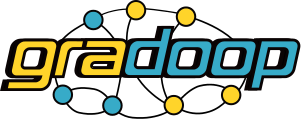-
Notifications
You must be signed in to change notification settings - Fork 89
Binary Graph Collection Operators
This section provides an overview of binary graph collection operators, which consume two GraphCollections as input.
| Binary Graph Collection Operators |
|---|
| Union |
| Intersection |
| Difference |
| Equality |
Given two collections, the union operator creates a GraphCollection that includes all logical graphs of both input collections. Graph equality is based on their identifiers.
| Method | Description |
|---|---|
| union | Returns the union of both GraphCollections. |
Consider the Social Network example graph, which contains multiple logical graphs with different relations. This example takes two graph collections with different logical graphs from the social network graph and creates the union of both.
FlinkAsciiGraphLoader loader = getSocialNetworkLoader();
GraphCollection col02 = loader.getGraphCollectionByVariables("g0", "g2");
GraphCollection col12 = loader.getGraphCollectionByVariables("g1", "g2");
GraphCollection result = col02.union(col12); // g0, g1, g2result now contains the logical graphs g0, g1 and g2.
Given two collections, the intersection operator creates a GraphCollection that includes all logical graphs that exist in both input collections. Graph equality is based on their identifiers.
| Method | Description |
|---|---|
| intersect | Returns the intersection of both GraphCollections. |
| intersectWithSmallResult | Returns the intersection of both GraphCollections. Alternate implementation that works faster if the other GraphCollection is small (e.g. fits in the workers main memory). |
Consider the Social Network example graph, which contains multiple logical graphs with different relations. This example takes two graph collections with different logical graphs from the social network graph and creates the intersection of both.
FlinkAsciiGraphLoader loader = getSocialNetworkLoader();
GraphCollection col02 = loader.getGraphCollectionByVariables("g0", "g2");
GraphCollection col12 = loader.getGraphCollectionByVariables("g1", "g2");
GraphCollection result = col02.intersect(col12); // g2result now contains the logical graph g2.
Given two collections, the difference operator creates a GraphCollection that includes all logical graphs that are contained in that collection but not in the other. Graph equality is based on their identifiers.
| Method | Description |
|---|---|
| difference | Returns the difference of both GraphCollections. |
| differenceWithSmallResult | Returns the difference of both GraphCollections. Alternate implementation that works faster if the intermediate result (list of graph identifiers) is small (e.g. fits in the workers main memory). |
Consider the Social Network example graph. This graph contains multiple logical graphs with different relations. This example takes two graph collections with different logical graphs from the social network graph and creates the difference of both.
FlinkAsciiGraphLoader loader = getSocialNetworkLoader();
GraphCollection col02 = loader.getGraphCollectionByVariables("g0", "g2");
GraphCollection col12 = loader.getGraphCollectionByVariables("g1", "g2");
GraphCollection result = col02.difference(col12); // g0result now contains the logical graph g0.
Given two collections, the equality operator determines whether they are equal. The operator is implemented by the GraphCollection. The equality operator takes another GraphCollection as its input and outputs a DataSet<Boolean> that contains a single boolean value.
| Method | Description |
|---|---|
| equalsByGraphIds | Compares IDs of the graph heads of the GraphCollections for equality. |
| equalsByGraphElementIds | Compares IDs of the vertices and edges of the GraphCollections for equality. |
| equalsByGraphElementData | Compares data of the vertices and edges of the GraphCollections for equality. |
| equalsByGraphData | Compares data of the vertices, edges and graph heads of the GraphCollections for equality. |
Consider the Social Network example graph. This graph contains multiple logical graphs with different relations. This example takes two graph collections from the social network graph and checks for equality.
FlinkAsciiGraphLoader loader = getSocialNetworkLoader();
GraphCollection col1 = loader.getGraphCollectionByVariables("g0", "g1");
GraphCollection col2 = loader.getGraphCollectionByVariables("g0", "g1");
DataSet<Boolean> result = col1.equalsByGraphElementData(col2);
boolean equal = result.collect().get(0); // trueresult is a DataSet<Boolean> that contains true.
